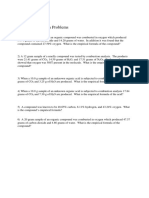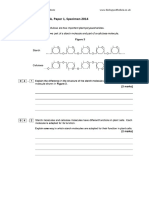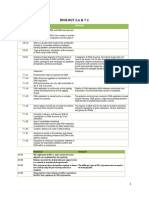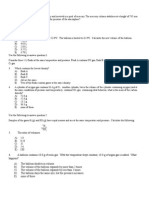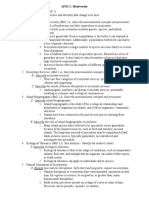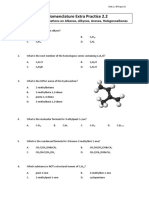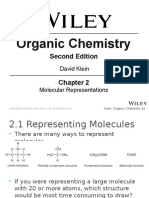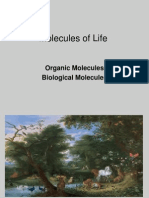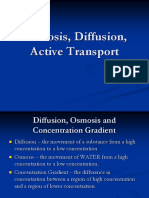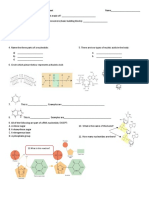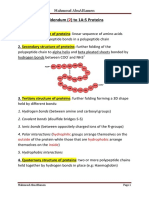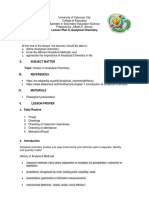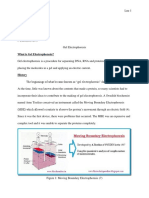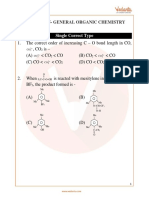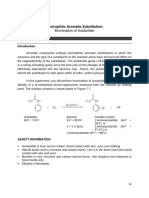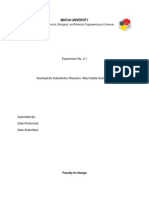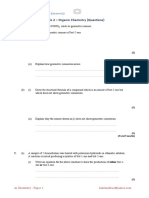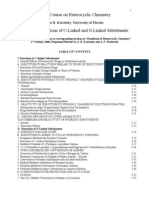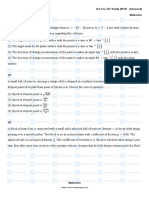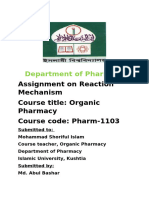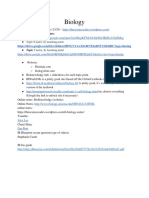Introduction To Organic Chemistry
Introduction To Organic Chemistry
Uploaded by
Devendran MahendhrenCopyright:
Available Formats
Introduction To Organic Chemistry
Introduction To Organic Chemistry
Uploaded by
Devendran MahendhrenOriginal Description:
Original Title
Copyright
Available Formats
Share this document
Did you find this document useful?
Is this content inappropriate?
Copyright:
Available Formats
Introduction To Organic Chemistry
Introduction To Organic Chemistry
Uploaded by
Devendran MahendhrenCopyright:
Available Formats
NORFAZRIN MOHD HANIF
Pharmaceutical Chemistry
School of Pharmacy, MSU
SPH1203
Organic
Chemistry
Lecturers
1. Nik Nur Shamiha Nik Dzulkefli
nik_nurshamiha@msu.edu.my
03-55216473, 012-920 1066
2. Norfazrin Mohd. Hanif
norfazrin_mohdhanif@msu.edu.my , fazrinhanif@gmail.com
03-55216473 , 012-6681072
List of Chapters
1. Introduction To Organic Chemistry
2. Nomenclature & Isomerism
3. Aliphatic Hydrocarbon
4. Cycloalkanes
5. Concept of aromacity
6. Alcohol
7. Ethers
8. Aldehyde & Ketone
9. Carboxylic Acid
10. Amines
11. Heterocyclic Chemistry
SchemeofWork(SOW)
DATE TOPIC ASSIGNMENT TEST
10/02/14 14/02/14
WEEK 1
Topic 1 : Introduction to Organic Chemistry
Lecturer: Fazrin
17/02/14 21/02/14
WEEK 2
Topic 2 : Nomenclature & Isomerism
Lecturer: Fazrin
Practical 1 (A)
(Fazrin)
24/02/14 28/02/14
WEEK 3
Topic 3: Aliphatic Hydrocarbons (Part 1)
Lecturer: Fazrin
Practical 1 (B)
(Fazrin)
03/03/14 07/03/14
WEEK 4
Topic 3: Aliphatic Hydrocarbons (Part 2)
Lecturer: Fazrin
Quiz 1
(Fazrin)
Practical 2 (A)
(Fazrin)
10/03/14 14/03/14
WEEK 5
Topic 4 : Cycloalkanes (Part 1)
Lecturer: Fazrin
Practical 2 (B)
(Fazrin)
17/03/14 21/03/14
WEEK 6
Topic 4 : Cycloalkanes (Part 2)
Lecturer: Fazrin
Practical 3 (A)
(Fazrin)
24/03/14 28/03/14
WEEK 7
Topic 5 : Concept of aromacity (Part 1)
Lecturer: Fazrin
Quiz 2
(Fazrin)
Practical 3(B)
(Fazrin)
31/03/14 04/04/14
WEEK 8
Topic 5 : Concept of aromacity (Part 2)
Lecturer: Fazrin
Assignment
07/04/14 11/04/14
WEEK 9
Mid Sem Exam
14/04/14 18/04/14
WEEK 10
Mid Sem Exam
SchemeofWork(SOW)(contd)
21/04/14 25/04/14
WEEK 11
Topic 6 : Alcohol
Lecturer: Nik Shamiha
28/04/14 02/05/14
WEEK 12
Topic 7 : Ethers
Lecturer: Nik Shamiha
Practical 4 (A)
(Nik)
05/05/14 09/05/14
WEEK 13
Topic 8 : Aldehyde & Ketone
Lecturer: Nik Shamiha
Quiz 3
(Nik)
Practical 4 (B)
(Nik)
12/05/14 16/05/14
WEEK 14
Topic 9 : Carboxylic Acid
Lecturer: Nik Shamiha
Practical 5 (A)
(Nik)
19/05/14 23/05/14
WEEK 15
Topic 10 : Amines (Part 1)
Lecturer: Nik Shamiha
Quiz 4
(Nik)
Practical 5 (B)
(Nik)
26/05/14 30/05/14
WEEK 16
Topic 10 : Amines (Part 2)
Lecturer: Nik Shamiha
02/06/14 06/06/14
WEEK 17
Topic 10 : Heterocyclic Chemistry (Part 1)
Lecturer: Nik Shamiha
Quiz 5
(Nik)
Lab Test
(Nik)
09/06/14 13/06/14
WEEK 18
Topic 10 : Heterocyclic Chemistry (Part 2)
Lecturer: Nik Shamiha
16/06/14 20/06/14
WEEK 19
Revision
23/06/14 04/07/14
WEEK 20 & 21
Final Exam
SPH1203OrganicChemistry
Assessment
Assignment Quiz Practical Lab Test
Mid Term
Exam
Final Exam
5% 10% 10% 5% 20% 50%
1
Assignment
5
Quizzes
5
Practical
1
Lab test
1 Mid Term
Exam
1 Final Exam
Thank you
1-8
SPH 1203 ORGANIC CHEMISTRY
Chapter 1
Introduction to Organic Chemistry
NORFAZRIN MOHD HANIF
Pharmaceutical Chemistry
School of Pharmacy, MSU
1-9
CHAPTER OUTLINE
Introduction
Classification of Organic Compounds
Functional Groups
Electronegativity
Types of Reactions
1-10
1. Introduction - Organic Chemistry
Besides carbon, the most common elements in
organic compounds are hydrogen, oxygen,
nitrogen, sulfur, and the halogens.
All of the preceding elements are non-metals,
therefore organic compounds have covalent
bonding.
Any structural formula that obeys the bonding
rules in the following table probably represents a
possible compound.
A drawn structure that breaks the bonding rules is
unlikely to exist.
1-11
Bonding in Organic Compounds
Besides carbon, the most common elements in
organic compounds are hydrogen, oxygen,
nitrogen, sulfur, and the halogens.
All of the preceding elements are non-metals,
therefore organic compounds have covalent
bonding.
Any structural formula that obeys the bonding
rules in the following table probably represents a
possible compound.
A drawn structure that breaks the bonding rules is
unlikely to exist.
1-12
Numbers and Types of Bonds for
Common Elements in Organic Compounds
Application of the octet rule indicates that these elements should
bond as shown below:
1-13
Identifying Valid & Incorrect
Structural Formulas
An Example
Two structural formulas are shown above.
Which on does not represent a real
compound?
1-14
Identifying Valid & Incorrect
Structural Formulas
An Example
Two structural formulas are shown above.
Which on does not represent a real
compound?
In structure (a) each H and halogen has one
bond, each C has four bonds, and each O has
two bonds.
This is a valid structure.
1-15
Identifying Valid & Incorrect
Structural Formulas
An Example
As we examine (b), we note that each H
has one bond, each C has four bonds, the
N has three bonds, BUT the O has three
bonds.
The O should only have two bonds.
Therefore (b) is not a valid structure.
1-16
Identifying Incorrect Structural Formulas
The structural formula above appears in a
recent chemistry book. Check the number
of bonds to each atom and determine
whether any bonding rules are violated.
1-17
Identifying Incorrect Structural Formulas
This is not a valid
structure for caffeine!
O should have two
bonds, C should
have 4 bonds
Each N should
have 3 bonds
Each C should
have 4 bonds
1-18
Identifying Incorrect Structural Formulas
This is a valid structure for
caffeine!
1-19
2. Classification of Organic Compounds
1-20
Classification of Organic Compounds
Saturated compounds: Open chain compounds in which
carbon atoms of parent chain are bonded with single
bonds are called saturated acyclic compounds. Ex:
1-21
Classification of Organic Compounds
Unsaturated compounds: The open chain organic
compounds in which parent chain contains one or more
carbon-carbon double bonds or triple bonds are called
unsaturated acyclic compounds. Ex:
1-22
Classification of Organic Compounds
Alicyclic compounds: Organic compound that is both
aliphatic and cyclic. They contain one or more all-carbon
rings which may be either saturated or unsaturated, but
do not have aromatic character.For example
1-23
Classification of Organic Compounds
Aromatic compounds: Benzene is the parent aromatic
hydrocarbon. The organic compounds containing one or
more isolated or fused benzene rings and their
functionalized derivatives are called aromatic compounds
or benzenoid compound. For example:
1-24
Classification of Organic Compounds
Alicyclic heterocyclic compounds: The aliphatic cyclic
compounds containing one or more hetero atoms in their
ring are called alicyclic heterocyclic compounds.
For example
1-25
Classification of Organic Compounds
Aromatic heterocyclic compounds: The aromatic cyclic
compounds containing one or more hetero atoms in their
molecules are called aromatic heterocyclic compounds.
Example
1-26
3. Functional Groups
Functional group: an atom or group of atoms
within a molecule that shows a characteristic set
of physical and chemical properties
Functional groups are important for three
reason; they are
1. the units by which we divide organic compounds into
classes
2. the sites of characteristic chemical reactions
3. the basis for naming organic compounds
1-27
Functional Groups
1-28
Functional Groups
1-29
Alcohols
Contain an -OH (hydroxyl) group
General formula : CnH2n+1OH or CnH2n+2O
Ethanol may also be written as a condensed
structural formula
H-C-C-O-H
H
H
H
H
:
:
-C-O-H
Ethanol
(an alcohol)
Functional
group
CH
3
-CH
2
-OH CH
3
CH
2
OH
or
1-30
Alcohols
alcohols are classified as primary (1), secondary (2),
or tertiary (3) depending on the number of carbon
atoms bonded to the carbon bearing the -OH group
CH
3
-C-OH
CH
3
CH
3
CH
3
-C-OH
CH
3
H
CH
3
CH
3
CH
3
-C-OH
A 1 alcohol A 2 alcohol A 3 alcohol
1-31
Alcohols
there are two alcohols with molecular formula C
3
H
8
O
CH
3
CH
2
CH
2
OH
CH
3
CHCH
3
OH
H-C-C-C-O-H
H
H
H
H
H
H
C-C-C-H
H
H
OH
HH H
H
or
or
a 2 alcohol
a 1 alcohol
1-32
Amines
General formula : CnH2n+1NH2
Contain an amino group; nitrogen bonded to one,
two, or three carbon atoms
an amine may by 1, 2, or 3
C H
3
N H
H
C H
3
N H
C H
3
C H
3
N
C H
3
C H
3
Methylamine
(a 1 amine)
Dimethylamine
(a 2 amine)
Trimethylamine
(a 3 amine)
:
:
:
1-33
Aldehydes and Ketones
General formula aldehydes: CnH2nO
General formula ketone : CnH2nO
Contain a carbonyl (C=O) group
C H
O
CH
3
-C-H
O
CH
3
-C-CH
3
O
C
O
Functional
group
Acetaldehyde
(an aldehyde)
Acetone
(a ketone)
Functional
group
1-34
Carboxylic Acids
General formula : CnH2nO2 or CnH2n+1COOH
Contain a carboxyl (-COOH) group
C O
O
H CH
3
-C-O-H
O
CH
3
COOH CH
3
CO
2
H
: :
:
:
or or
Acetic aci d
(a carboxyli c acid)
Functional
group
1-35
Carboxylic Esters
Ester: a derivative of a carboxylic acid in which
the carboxyl hydrogen is replaced by a carbon
group
General formula : CnH2nO2
C O
O
Functional
group
CH
3
-C-O-CH
2
-CH
3
Ethyl acetate
(an ester)
:
:
: :
O
1-36
Carboxylic Amide
Carboxylic amide, commonly referred to as an
amide: a derivative of a carboxylic acid in which
the -OH of the -COOH group is replaced by an
amine
General formula : CnH2n+1CONH2
CH
3
-C-N-H
H
Acetamide
(a 1 amide)
O
C N
O
Functional
group
1-37
4. Electronegativity
Electronegativity:
a measure of the force of an atoms attraction of
electrons that is shares in a chemical bond with
another atom.
1-38
Electrophile And Nucleophile
Reagents in organic reactions can be classified either
electrophiles or nucleophiles depending on whether they
attack regions of high electron density (-) or regions of
low electron density (+).
regions of low electron density (+) also known as
electron-deficient sites.
Electrophiles:
- a species (ion or molecule) which attacks by a negatively
charged carbon atom by accepting an electron pair.
- Lewis acid
-positive ions or molecule that have an electron-deficient
atom (+).
- known as electrophilic reagents
1-39
Electrophile And Nucleophile
Nucleophile:
- a species (ion or molecule) that attacks a positively
charged carbon atom by donating an electron pair to
form a dative covalent bond.
- known as nucleophilic reagents
- Lewis bases
- negative ions or molecules that have at least one
lone pair of electrons.
1-40
Examples of nucleophiles and electrophiles
OH, RO
C
R-OH
C C
H
2
O
C
+
RN
2
+
BF
3
AlCl
3
CN
-
nucleophiles
(donors of electron pairs)
electrophiles
(acceptors of electron pairs)
CI, Br, I
(carbanion)
NH
3
, RNH
2
Reducing agents
Oxidising agents
H
+
(or H
3
O
+
), NO
2
+
(nitronium ion)
Cl
2
, Br
2
(carbocation)
FeBr
3
, ZnCl
2
Cl
+
, Br
+
, I
+
1-41
Examples of nucleophiles and electrophiles
CH
3
N
H
H
CH
3
CH
2
Cl
CH
3
N
H
H
CH
2
CH
3
Cl
nucleophile electrophile
+
-
1-42
5. TYPES OF REACTIONS
Substitutions
Additions
Eliminations
Rearrangements
1-43
SUBSTITUTION REACTIONS
Substitutions are the characteristic reactions of saturated
compounds such as alkanes and alkyl halides, and of
aromatic compounds (even though they are unsaturated).
In a substitution, one group replaces another.
For example, methyl chloride reacts with sodium
hydroxide to produce methyl alcohol and sodium
chloride:
In this reaction a hydroxide ion from sodium hydroxide
replaces the chlorine of methyl chloride.
1-44
ADDITIONS REACTIONS
Additions are characteristic of compounds with multiple
bonds. Ethene, for example, reacts with bromine by an
addition. In an addition all parts of the adding reagent
appear in the product; two molecules become one.
1-45
ELIMINATIONS REACTIONS
Eliminations are the opposite of additions. In elimination
one molecule loses the elements of another small
molecule. Elimination reactions give us a method for
preparing compounds with double and triple bonds.
Eg: Dehydrohalogenation, a reaction that is used to
prepare alkenes. In dehydrohalogenation, as the word
suggests, the elements of a hydrogen halide are
eliminated. An alkyl halide becomes an alkene:
1-46
REARRANGEMENT REACTIONS
In a rearrangement a molecule undergoes a
reorganization of its constituent parts. For example,
heating thefollowing alkene with a strong acid causes the
formation of another isomeric alkene.
In this rearrangement not only have the positions of the
double bond and a hydrogen atom changed but a methyl
group has moved from one carbon to another.
1-47
THANK YOU!
You might also like
- A Level Organic Chemistry NotesDocument68 pagesA Level Organic Chemistry NotesTeejay Makazhu100% (14)
- Empirical Formula Problems and KeyDocument4 pagesEmpirical Formula Problems and KeyJime Ryle Althea GazzinganNo ratings yet
- Practice Makes Perfect in Chemistry: Acids, Bases, and Salts with AnswersFrom EverandPractice Makes Perfect in Chemistry: Acids, Bases, and Salts with AnswersNo ratings yet
- ALKANESDocument20 pagesALKANESLaely INNo ratings yet
- Structure of Organic CompoundsDocument27 pagesStructure of Organic CompoundsBetty Weiss100% (1)
- Empirical and Molecular FormulasDocument11 pagesEmpirical and Molecular FormulasWarley JabelNo ratings yet
- Alkanes HQDocument28 pagesAlkanes HQHaslimi Bin HassanNo ratings yet
- Organic ChemistryDocument38 pagesOrganic ChemistryJackie DidaNo ratings yet
- An Introduction To Organic Chemistry:: The Saturated HydrocarbonsDocument73 pagesAn Introduction To Organic Chemistry:: The Saturated HydrocarbonsGabz Gabby0% (1)
- 4.6 Exercise 1 - Aromatic ChemistryDocument1 page4.6 Exercise 1 - Aromatic ChemistryridithaNo ratings yet
- Introduction To Organic ChemistryDocument16 pagesIntroduction To Organic ChemistryJan Mykel PestañoNo ratings yet
- Alkynes: An Introduction To Organic Synthesis: Based On Mcmurry'S Organic Chemistry, 7 EditionDocument26 pagesAlkynes: An Introduction To Organic Synthesis: Based On Mcmurry'S Organic Chemistry, 7 EditionElisha NiñaNo ratings yet
- IUPAC Nomenclature of Organic Compounds AlkanesDocument14 pagesIUPAC Nomenclature of Organic Compounds AlkanesIRISH REEM LINAOTANo ratings yet
- A Molecular Approach Chapter 11Document191 pagesA Molecular Approach Chapter 11Stephen0% (1)
- 1.2 Carbohydrates Exam QuestionsDocument20 pages1.2 Carbohydrates Exam QuestionsMahumNo ratings yet
- Rates and EquilibriaDocument15 pagesRates and EquilibriaThaarvena RetinaNo ratings yet
- Biology IB SLDocument28 pagesBiology IB SLRaynaahNo ratings yet
- CH 5 Practice ProblemsDocument16 pagesCH 5 Practice Problemsjaskaran singhNo ratings yet
- Molecules of LifeDocument38 pagesMolecules of LifeAmanda ArceoNo ratings yet
- Apes U2 Outline BiodiversityDocument2 pagesApes U2 Outline Biodiversityapi-352694884No ratings yet
- Phase DiagramDocument3 pagesPhase DiagramTing TCNo ratings yet
- Organic Chemistry Alkenes WorksheetDocument2 pagesOrganic Chemistry Alkenes Worksheetoc100% (1)
- Chapter 3 The Molecules of CellsDocument5 pagesChapter 3 The Molecules of Cellsmzunl25476No ratings yet
- CH 02Document72 pagesCH 02Handugan Quinlog NoelNo ratings yet
- Transcription in Prokaryotes PPTDocument50 pagesTranscription in Prokaryotes PPTKeneth CandidoNo ratings yet
- Preparation of Buffer: Experiment No: 1 DateDocument5 pagesPreparation of Buffer: Experiment No: 1 DatePraveen KumarNo ratings yet
- Amino Acids and Proteins WorksheetDocument2 pagesAmino Acids and Proteins WorksheetNatalie PembertonNo ratings yet
- NGSS Genetics UnitDocument71 pagesNGSS Genetics UnitPriscilla Ruiz100% (1)
- 1.3 Membrane Structure - Questions and AnswersDocument5 pages1.3 Membrane Structure - Questions and AnswersBordersv PoppwNo ratings yet
- Genetic Analysis: The Molecular Basis of Heredity, Variation, and EvolutionDocument39 pagesGenetic Analysis: The Molecular Basis of Heredity, Variation, and EvolutionlindaosaurNo ratings yet
- Basic Molecules of LifeDocument78 pagesBasic Molecules of LifeRavi ParkheNo ratings yet
- Electrochemistry Skill Builder: Metal Electrodes: Cu, ZN, Ag, Al Salt Solutions: 0.50 M and 1.0 M Solutions of Cu (NODocument20 pagesElectrochemistry Skill Builder: Metal Electrodes: Cu, ZN, Ag, Al Salt Solutions: 0.50 M and 1.0 M Solutions of Cu (NOCristel Angeline CellesNo ratings yet
- 6 BIO462 Chapter 6Document21 pages6 BIO462 Chapter 6Syafiqah SuhaimiNo ratings yet
- Osmosis, Diffusion, Active TransportDocument21 pagesOsmosis, Diffusion, Active TransportPrince SanjiNo ratings yet
- SCH 102: Organic Chemistry IDocument152 pagesSCH 102: Organic Chemistry IH to O ChemistryNo ratings yet
- A Molecular Approach ch13Document117 pagesA Molecular Approach ch13Stephen100% (1)
- Biomolecules TableDocument2 pagesBiomolecules TableJoya HossainNo ratings yet
- Nucleotides and Ribonucleic Acid Worksheet: 12.what Is This Reaction?Document2 pagesNucleotides and Ribonucleic Acid Worksheet: 12.what Is This Reaction?nurnisa janybekNo ratings yet
- Organic ChemistryDocument67 pagesOrganic ChemistryOlga DeeNo ratings yet
- Carboxylic Acids and EstersDocument31 pagesCarboxylic Acids and EstersleanneNo ratings yet
- Unit 5 ChemicChemical Kinetics and Equilibriumal Kinetics and Equilibrium Notes (Answers)Document22 pagesUnit 5 ChemicChemical Kinetics and Equilibriumal Kinetics and Equilibrium Notes (Answers)Muhammad IrfanNo ratings yet
- Proteins IAL Edexcel Unit 1Document4 pagesProteins IAL Edexcel Unit 1MahmoudNo ratings yet
- Pure Substances and MixturesDocument21 pagesPure Substances and MixturesJane Michelle EmanNo ratings yet
- Ach 101 - Organic Chemistry For AgricultureDocument138 pagesAch 101 - Organic Chemistry For AgricultureNana Kwame BoatengNo ratings yet
- Science 8 Course Outline 2016-2017Document2 pagesScience 8 Course Outline 2016-2017api-329970569No ratings yet
- Ionic Bonds GizmoDocument2 pagesIonic Bonds GizmoIvanBen Brown0% (2)
- CHM111 - Chemical Equilibrium NoteDocument22 pagesCHM111 - Chemical Equilibrium NoteolufemisongNo ratings yet
- Lecture 3 - Alkenes and AlkynesDocument55 pagesLecture 3 - Alkenes and AlkynesS JNo ratings yet
- Solubility and Simultaneous Equilibria: Chemistry: The Molecular Nature of Matter, 6EDocument59 pagesSolubility and Simultaneous Equilibria: Chemistry: The Molecular Nature of Matter, 6EEriani WulandariNo ratings yet
- Analytical Chemistry UnfinishedDocument3 pagesAnalytical Chemistry UnfinishedJobeth Presto AlonzoNo ratings yet
- Naming Alkanes WS 2Document4 pagesNaming Alkanes WS 2Carlos ChNo ratings yet
- Chapter 2: Elements, Compounds, Chemical Equations and CalculationsDocument88 pagesChapter 2: Elements, Compounds, Chemical Equations and Calculationsmuhammad farhanNo ratings yet
- Assistant Professor College of Biological and Chemical Engineering Department of Biotechnology Phone:0902643433Document31 pagesAssistant Professor College of Biological and Chemical Engineering Department of Biotechnology Phone:0902643433eyobNo ratings yet
- Lewis Theory of BondingDocument8 pagesLewis Theory of BondingJeto SantosNo ratings yet
- F324 Condensation PolymersDocument7 pagesF324 Condensation PolymersDoc_CrocNo ratings yet
- Stoichiometry: 12.3 Limiting Reagent and Percent YieldDocument54 pagesStoichiometry: 12.3 Limiting Reagent and Percent YieldA ANo ratings yet
- Gel ElectrophoresisDocument6 pagesGel Electrophoresisapi-385481351No ratings yet
- Microbial Associations/Interactio NS: Nanette Ramilo-Cruz, MD, DPAFPDocument50 pagesMicrobial Associations/Interactio NS: Nanette Ramilo-Cruz, MD, DPAFPKhatrinaNo ratings yet
- The Structure of DNA and RNADocument2 pagesThe Structure of DNA and RNADanielNacordaNo ratings yet
- Scientific Argumentation in Biology: 30 Classroom ActivitiesFrom EverandScientific Argumentation in Biology: 30 Classroom ActivitiesNo ratings yet
- WB JEE Engineering Solved Paper 2022 - NodrmDocument537 pagesWB JEE Engineering Solved Paper 2022 - NodrmNexus OpNo ratings yet
- Balancing Equations ModuleDocument3 pagesBalancing Equations ModuleRonie MalazzabNo ratings yet
- STPM Johor Chemistry Paper 1 2011 Trial (Edu - Joshuatly) Edu - JoshuatlyDocument20 pagesSTPM Johor Chemistry Paper 1 2011 Trial (Edu - Joshuatly) Edu - Joshuatlykokpin100No ratings yet
- ACS Study GuideDocument3 pagesACS Study Guidemyst8ry03513No ratings yet
- Chapter 2-AlkanesDocument63 pagesChapter 2-AlkanesNURUL BALQIS DZULKIFLINo ratings yet
- DPP 02 - Aromatic Nucleophilic Substitution Reactions - pdf-11Document7 pagesDPP 02 - Aromatic Nucleophilic Substitution Reactions - pdf-11JeetNo ratings yet
- CBSE Class 12 Chemistry Question Paper 2020Document20 pagesCBSE Class 12 Chemistry Question Paper 2020parv dhanoteNo ratings yet
- JEE Advanced General Organic Chemistry Important QuestionsDocument18 pagesJEE Advanced General Organic Chemistry Important QuestionsVaNo ratings yet
- OrganicChemistryChapter5 PDFDocument19 pagesOrganicChemistryChapter5 PDFJuliet Tatiana CumbeNo ratings yet
- Gujarat Technological UniversityDocument1 pageGujarat Technological UniversityShubham KoshtiNo ratings yet
- Chem Paper Thermo and Reaction Mechanism.Document12 pagesChem Paper Thermo and Reaction Mechanism.Harshvardhan GavankarNo ratings yet
- Substitution V EliminationDocument25 pagesSubstitution V Eliminationsourish kumarNo ratings yet
- Inorganic and Organometallic Reaction MechanismsDocument65 pagesInorganic and Organometallic Reaction MechanismsYoussef AliNo ratings yet
- Exam 2013Document26 pagesExam 2013cutinhawayneNo ratings yet
- Msc-Chemistry (Under CBCS) FIRST YEAR 2017-18 Two Semesters: 15 Weeks EachDocument37 pagesMsc-Chemistry (Under CBCS) FIRST YEAR 2017-18 Two Semesters: 15 Weeks EachHimanshiNo ratings yet
- EAS Lab Manual Not Edited 1Document4 pagesEAS Lab Manual Not Edited 1Téo Joca TherrienNo ratings yet
- CM134-1L Experiment 2.1Document8 pagesCM134-1L Experiment 2.1Christian JohnNo ratings yet
- CHM1 Organic3Document72 pagesCHM1 Organic3Hakim AbbasNo ratings yet
- Chemistry-XII Assigment Board Important QuestionsDocument18 pagesChemistry-XII Assigment Board Important QuestionsDisha SinghalNo ratings yet
- R3.4 Electron Pair Sharing Reactions 2Document6 pagesR3.4 Electron Pair Sharing Reactions 225malkhalailehNo ratings yet
- Unit1 Benzene and Its DerivativesDocument32 pagesUnit1 Benzene and Its DerivativesMahesh RathodNo ratings yet
- Lecture 3. Reactions of C-Linked and N-Linked Substituents: Short Course On Heterocyclic ChemistryDocument41 pagesLecture 3. Reactions of C-Linked and N-Linked Substituents: Short Course On Heterocyclic ChemistryeraborNo ratings yet
- AYJR 2022 (Advanced) - Paper 1 - MathonGoDocument48 pagesAYJR 2022 (Advanced) - Paper 1 - MathonGoupendra nagarNo ratings yet
- NSEC Solved Paper 2012Document19 pagesNSEC Solved Paper 2012swapnil narayanNo ratings yet
- ORGANIC PHARMACY AssignmentDocument14 pagesORGANIC PHARMACY AssignmentBashar AhmedNo ratings yet
- Organic Chemistry 10th Edition John Mcmurry 2024 Scribd DownloadDocument49 pagesOrganic Chemistry 10th Edition John Mcmurry 2024 Scribd Downloadvanchovashna66No ratings yet
- Reactions of Alkyl Halides: A. Nucleophilic Substitution (S RXN)Document25 pagesReactions of Alkyl Halides: A. Nucleophilic Substitution (S RXN)cikguhafidzuddinNo ratings yet
- r/IBO Group 4 Study Materials - Experimental SciencesDocument66 pagesr/IBO Group 4 Study Materials - Experimental SciencesHumberto RodríguezNo ratings yet
- Lab 07 SN1 and SN2 Reactions of Alkyl HalidesDocument12 pagesLab 07 SN1 and SN2 Reactions of Alkyl HalidesHuda ZackNo ratings yet

